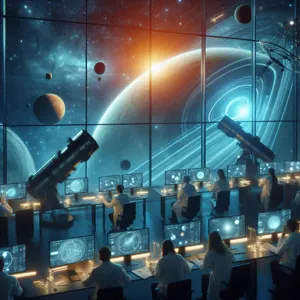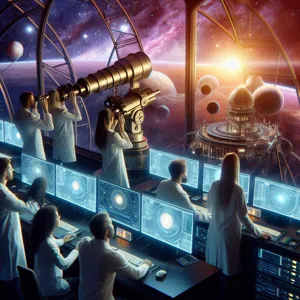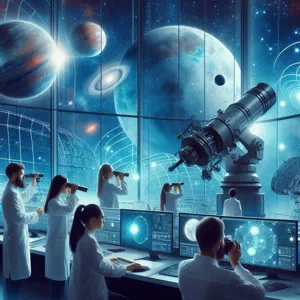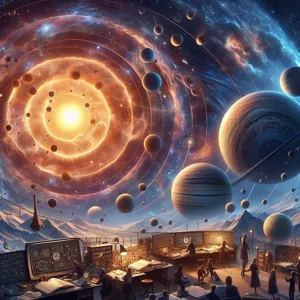The universe is a vast, mysterious expanse filled with celestial wonders, and among its most intriguing phenomena are white dwarfs.
These stellar remnants, the remnants of once-vibrant stars, offer a unique glimpse into the life cycle of celestial bodies and the intricate processes that govern our universe. Ranging from the faintest glimmers to the more luminous varieties, white dwarfs come in different types, each telling a story of stellar evolution, composition, and the ultimate fate of stars like our sun. In this blog post, we will embark on a journey through the cosmos to explore the different types of white dwarfs, delving into their formation, characteristics, and the fascinating roles they play in the grand tapestry of the universe. Join us as we uncover the secrets of these enigmatic stars and discover what they reveal about the life and death of matter in the cosmos.
1. Introduction to White Dwarfs

White dwarfs are one of the universe’s most fascinating celestial phenomena, representing the final evolutionary stage of stars like our Sun. As massive stars exhaust their nuclear fuel, they undergo dramatic transformations, shedding their outer layers and leaving behind an incredibly dense core. This core, composed predominantly of carbon and oxygen, is what we refer to as a white dwarf. Despite their small size—typically comparable to Earth—white dwarfs pack a staggering amount of mass, often exceeding that of our Sun, which leads to extraordinarily high densities.
Their name, “white dwarf,” reflects both their size and their appearance. These stars glow with a brilliant white light due to the intense heat generated during the final phases of their formation. Initially, they can be incredibly hot, with surface temperatures reaching upwards of 100,000 degrees Celsius. However, over billions of years, white dwarfs gradually cool and dim, eventually fading into black dwarfs—a theoretical stage that the universe has yet to witness, as it requires more time than the current age of the cosmos.
Understanding white dwarfs is crucial not only for comprehending stellar evolution but also for unraveling the mysteries of the universe’s fate. They serve as cosmic laboratories, providing insights into fundamental physical processes, such as quantum mechanics and thermodynamics. Moreover, white dwarfs can act as reliable markers for measuring cosmic distances through their use in Type Ia supernovae, which occur under specific conditions when a white dwarf accumulates enough mass to ignite a catastrophic nuclear reaction.
As we delve deeper into the intricacies of white dwarfs, we will explore their formation, characteristics, and the various types that exist, shedding light on these enigmatic remnants of stellar life. Join us on this cosmic journey to better understand the fascinating world of white dwarfs!
2. What is a White Dwarf?
A white dwarf is a fascinating celestial body that represents the final evolutionary stage of stars like our Sun. After exhausting their nuclear fuel, these stars undergo a dramatic transformation, shedding their outer layers and leaving behind a dense, hot core. This remnant, the white dwarf, is typically about the size of Earth but contains a mass comparable to that of the Sun, resulting in an astonishing density. Imagine a mass the size of a star compacted into a volume no larger than our planet—this is what makes white dwarfs so intriguing to astronomers and astrophysicists alike.
As a white dwarf cools over billions of years, it gradually fades and loses its brightness, yet it starts off incredibly hot, often exceeding temperatures of 100,000 degrees Celsius. It primarily consists of carbon and oxygen, products of helium fusion from the star’s earlier life stages. Unlike other types of stars, white dwarfs do not undergo fusion reactions; instead, they shine due to residual thermal energy left from their previous life cycle.
Additionally, the structure of a white dwarf is remarkable. It is supported against gravitational collapse by a quantum mechanical effect known as electron degeneracy pressure. This phenomenon arises from the principles of quantum physics, dictating that two electrons cannot occupy the same state simultaneously. As a result, white dwarfs are stable and can exist for billions of years, slowly cooling but never fully extinguishing.
Understanding white dwarfs is crucial not only for the study of stellar evolution but also for the broader context of the universe. They serve as cosmic benchmarks, helping astronomers measure distances across galaxies and providing insights into the fate of stars like our own. Exploring these remnants of stellar life not only enriches our understanding of the cosmos but also deepens our appreciation for the intricate processes that govern the life and death of stars.
3. The Life Cycle of Stars Leading to White Dwarfs

The life cycle of stars is a fascinating journey that ultimately leads to the formation of white dwarfs, representing the final chapter for many of the universe’s stellar inhabitants. To grasp how a star transitions into a white dwarf, it’s essential to first understand the stages of stellar evolution.
Stars are born in vast clouds of gas and dust known as nebulae. Under the force of gravity, these materials collapse and heat up, eventually igniting nuclear fusion in their cores. During this early phase, called the main sequence, stars like our Sun shine brightly for millions to billions of years, fusing hydrogen into helium. This phase is marked by stability, where the outward pressure from nuclear fusion balances the inward pull of gravity.
As a star exhausts its hydrogen fuel, it undergoes a series of transformations. For medium-sized stars, like the Sun, once the hydrogen is depleted, the core contracts and heats up, while the outer layers expand and cool, leading to the creation of a red giant. This stage is characterized by dramatic changes: the star’s outer envelope swells, potentially engulfing nearby planets. Eventually, the core becomes hot enough for helium fusion, producing carbon and oxygen.
However, this process is short-lived. Once the helium is depleted, the core can no longer sustain fusion reactions as it lacks the necessary mass to fuse heavier elements. At this point, the outer layers are expelled, creating a beautiful planetary nebula that glows with the remnants of nuclear reactions. What remains is the hot, dense core of the star, now a white dwarf. This stellar remnant is composed mostly of carbon and oxygen and is incredibly hot—radiating light and heat as it gradually cools over billions of years.
In contrast, more massive stars undergo a more explosive end. They may go supernova, leaving behind neutron stars or black holes rather than white dwarfs. Thus, the life cycle of stars is not only a tale of the life and death of these celestial giants but also a reminder of the cosmic processes that lead to the formation of white dwarfs—one of the universe’s most intriguing phenomena. Understanding this cycle not only enriches our knowledge of stellar evolution but also highlights the delicate balance of forces that govern the life of stars in the cosmos.
4. Types of White Dwarfs: An Overview
When delving into the fascinating world of white dwarfs, it’s essential to understand that not all of these stellar remnants are created equal. White dwarfs come in several distinct types, each characterized by their unique compositions and evolutionary histories. Here’s a closer look at the primary categories of white dwarfs that astronomers study:
1. **Carbon-Oxygen White Dwarfs**: The most common type of white dwarf, carbon-oxygen (C-O) white dwarfs, are the remnants of stars like our Sun. They form when a star exhausts its nuclear fuel and ejects its outer layers, leaving behind a core primarily composed of carbon and oxygen. These white dwarfs typically have a mass similar to that of the Sun but are compressed into a volume comparable to that of Earth, resulting in incredibly high densities.
2. **Oxygen-Neon White Dwarfs**: Less common than their carbon-oxygen counterparts, oxygen-neon (O-Ne) white dwarfs originate from more massive stars. These stars undergo more complex fusion processes, resulting in a core rich in oxygen and neon. O-Ne white dwarfs are often found in binary systems, where they can accumulate material from a companion star, potentially leading to explosive phenomena such as novae.
3. **Helium White Dwarfs**: Formed from low-mass stars that do not undergo the same extensive fusion processes as heavier stars, helium white dwarfs are primarily composed of helium. These stars may evolve rapidly through their lifecycles and shed their outer layers, leaving behind a core that cools and fades over time. While relatively rare, they provide crucial insight into the evolution of low-mass stars and the dynamics of stellar formation.
4. **Daqting White Dwarfs**: A fascinating subset, DA white dwarfs are characterized by their hydrogen-rich atmospheres. Their spectra exhibit strong hydrogen lines, which indicate that hydrogen is the dominant element in their composition. These stars are typically the end point of stars that have gone through a helium burning phase and have lost their outer layers. On the other hand, DB white dwarfs contain mostly helium in their atmospheres, showcasing the diversity of stellar remnants.
5. **Magnetic White Dwarfs**: These intriguing objects possess strong magnetic fields that can significantly influence their surroundings. Magnetic white dwarfs can be either DA or DB types, but their magnetic fields can affect how they interact with nearby matter, leading to unique behaviors such as the formation of accretion disks or the emission of synchrotron radiation.
Understanding these different types of white dwarfs not only enriches our knowledge of stellar evolution but also sheds light on the ultimate fate of stars in our universe. Each type carries its own story, offering a glimpse into the complex life cycles of stars and their eventual transformation into these compact remnants. As we continue to explore the cosmos, the study of white dwarfs remains a captivating frontier in the field of astrophysics.
5. Carbon-Oxygen White Dwarfs

Carbon-oxygen white dwarfs represent one of the most common types of white dwarfs in our universe, and they offer a fascinating glimpse into the final stages of stellar evolution. Formed from stars that were initially between 8 and 10 times the mass of our Sun, these remnants arise after a star has exhausted its nuclear fuel, shedding its outer layers and leaving behind a dense core. As the name suggests, the primary constituents of these white dwarfs are carbon and oxygen, products of helium burning that occurs during the star’s later life stages.
The structure of carbon-oxygen white dwarfs is particularly intriguing. These stars typically have a mass range of about 0.5 to 1.4 solar masses, while their radii are roughly similar to that of Earth, resulting in an incredibly high density. A sugar-cube-sized amount of material from a carbon-oxygen white dwarf could weigh as much as a car! This density arises from the electron degeneracy pressure, a quantum mechanical effect that prevents the collapse of the star under its own gravity.
What makes carbon-oxygen white dwarfs especially interesting is their potential for future cosmic events. When they reach a critical mass known as the Chandrasekhar limit—approximately 1.4 solar masses—they can no longer support themselves against gravitational collapse. This often leads to a cataclysmic explosion known as a Type Ia supernova, a phenomenon critical for understanding the expansion of the universe and providing distance measurements in cosmology.
Observationally, carbon-oxygen white dwarfs can be identified by their characteristic spectral lines, especially in the ultraviolet and optical wavelengths. As they cool over billions of years, they transition from bright, hot stars to faint remnants, gradually fading into the cosmic background. The study of these stellar remnants not only deepens our understanding of stellar life cycles but also sheds light on the elemental composition of the universe, as these white dwarfs contribute to the chemical enrichment of galaxies through supernovae.
In summary, carbon-oxygen white dwarfs are more than just stellar leftovers; they are pivotal players in the grand narrative of cosmic evolution, bridging the gap between life, death, and rebirth in the universe. Their study continues to unveil the mysteries of the cosmos, inviting astronomers to explore the intricate tapestry of stellar life that shapes our galactic neighborhood.
6. Helium White Dwarfs
Helium white dwarfs represent a fascinating category within the spectrum of stellar remnants, arising from the evolution of stars that initially had a mass between about 0.5 and 2 solar masses. Unlike their more common carbon-oxygen counterparts, these intriguing celestial objects emerge when stars exhaust their hydrogen fuel and undergo a complex process of helium fusion. The result is a compact core composed predominantly of helium, with a unique set of characteristics that distinguish them from other white dwarfs.
One of the most captivating features of helium white dwarfs is their relatively low mass—typically ranging from 0.3 to 0.6 solar masses. This lower mass is a direct consequence of the star’s inability to fuse heavier elements, leading to a different evolutionary path. As these stars enter the white dwarf phase, they shed their outer layers, often leaving behind a helium-rich core that cools and contracts over time.
The spectrum of helium white dwarfs also sets them apart. Their atmospheric composition is predominantly helium, with traces of hydrogen and other elements. This distinctive characteristic not only influences their color, giving them a bluish hue, but also plays a critical role in their evolution. As they cool, helium white dwarfs can transition into a state known as a crystallizing white dwarf, where atoms begin to form a solid lattice structure—a process that could take billions of years.
Understanding helium white dwarfs is essential for astronomers as they can provide insights into the late stages of stellar evolution and the dynamics of binary systems. In cases where a helium white dwarf is part of a binary pair, it can accrete material from its companion star, potentially leading to explosive events such as nova outbursts. Thus, these subtle yet significant remnants offer a glimpse into the complex life cycles of stars and the ongoing processes that shape our universe.
In summary, helium white dwarfs are more than just cosmic leftovers; they are key players in the grand narrative of stellar evolution, illuminating the paths that stars take as they approach the end of their life cycles. As we continue to explore the cosmos, these enigmatic objects remind us of the intricate tapestry of creation, destruction, and rebirth that defines our universe.
7. Oxygen-Neon White Dwarfs

Oxygen-neon white dwarfs represent a fascinating class of stellar remnants that offer a unique glimpse into the life cycles of massive stars. Formed from the cores of stars that have exhausted their nuclear fuel, these white dwarfs are predominantly composed of oxygen and neon, the byproducts of helium fusion in the late stages of a star’s life.
What sets oxygen-neon white dwarfs apart is their origin. Unlike the more common carbon-oxygen white dwarfs, which arise from stars that have undergone a series of helium flashes, oxygen-neon white dwarfs typically emerge from stars with a mass between 8 to 10 solar masses, which experience complex fusion processes before shedding their outer layers. The result is a dense core that can pack more than the mass of the Sun into a volume no larger than that of Earth.
These celestial bodies are characterized by their incredibly high temperatures, often exceeding 100,000 Kelvin. Despite their initial heat, oxygen-neon white dwarfs cool over time, gradually fading from view. Their surface temperatures, along with their unique chemical compositions, make them valuable to astronomers studying stellar evolution and the intricate processes that govern the life cycle of stars.
Interestingly, oxygen-neon white dwarfs can also play a role in the formation of Type Ia supernovae. In certain binary systems, if they accumulate enough mass from a companion star, they can reach the Chandrasekhar limit (approximately 1.4 solar masses). This critical threshold can lead to a runaway fusion reaction, resulting in a cataclysmic explosion that outshines entire galaxies for a brief period. This phenomenon not only illuminates the night sky but also serves as a vital tool for measuring cosmic distances.
As we continue to explore the cosmos, oxygen-neon white dwarfs stand as a testament to the complexity and diversity of stellar remnants, inviting us to delve deeper into the mysteries of the universe and the life cycles of stars that have come and gone.
8. The Role of Mass in White Dwarf Classification
When it comes to classifying white dwarfs, mass plays a pivotal role that cannot be overlooked. These stellar remnants, which are the remnants of stars that have exhausted their nuclear fuel, offer a fascinating glimpse into the life cycle of stars, and their mass significantly influences their characteristics and evolutionary paths.
White dwarfs can be broadly categorized into two main types based on their mass: the more common carbon-oxygen white dwarfs and the rarer helium white dwarfs. Carbon-oxygen white dwarfs, typically formed from stars with masses between about 1 to 8 solar masses, represent the majority of white dwarfs in the universe. These stellar corpses are dense and hot, with a mass comparable to that of the Sun, yet compressed into a volume no larger than that of Earth. Their high mass leads to a greater gravitational pull, which in turn affects their cooling rates and luminosity.
On the other hand, helium white dwarfs arise from lower-mass stars, typically those that are less than 2.2 solar masses. These stars evolve differently and shed their outer layers, leaving behind a core primarily composed of helium. Helium white dwarfs are generally less massive and cooler than their carbon-oxygen counterparts, exhibiting distinct evolutionary characteristics and lifetimes.
The mass of a white dwarf also determines its fate. Those that exceed a certain mass limit, known as the Chandrasekhar limit (approximately 1.4 solar masses), can lead to dramatic events, such as Type Ia supernovae. This explosion occurs when a white dwarf accretes enough matter from a companion star to push it over the Chandrasekhar limit, triggering runaway nuclear fusion and resulting in a catastrophic release of energy.
Thus, understanding the role of mass in white dwarf classification not only enriches our knowledge of these stellar remnants but also provides valuable insights into the broader mechanics of stellar evolution and the life cycles of stars. As astronomers continue to explore the cosmos, the study of white dwarfs remains a fascinating window into the complexities of our universe.
9. The Importance of Temperature and Luminosity
When diving into the realm of white dwarfs, two critical parameters come to the forefront: temperature and luminosity. These celestial remnants, the end products of stellar evolution for stars like our Sun, reveal much about their past and future through these two characteristics.
Temperature is a defining feature of a white dwarf. Upon its formation, a white dwarf is incredibly hot, reaching surface temperatures upwards of 100,000 Kelvin. This extreme heat results from the gravitational collapse of the star, which compresses the core and causes residual thermal energy to persist. As time unfolds, white dwarfs gradually cool, transitioning from their initial scorching temperatures to a more subdued state, eventually settling at just a few thousand Kelvin. This cooling process can take billions of years, serving as a cosmic clock that helps astronomers understand the age of the white dwarf and, by extension, the star’s evolutionary timeline.
Luminosity, on the other hand, is intrinsically linked to temperature but also influenced by the white dwarf’s size and composition. As these stars cool, they emit less light, making their luminosity a crucial indicator of their current state. The relationship between temperature and luminosity follows the principles laid out by the Stefan-Boltzmann Law, which states that a star’s brightness is proportional to the fourth power of its temperature. Thus, even a slight decrease in temperature can lead to a significant drop in luminosity. For astronomers, measuring the luminosity of a white dwarf provides vital clues about its temperature, allowing for more accurate modeling of its evolutionary path.
Understanding the interplay between temperature and luminosity not only contributes to our knowledge of individual white dwarfs but also enhances our grasp of stellar populations and the life cycles of stars. By studying these fascinating remnants, we unlock the secrets of the cosmos, piecing together the vast history of our universe and the lifecycle of stars that have long since burned out. In essence, the temperature and luminosity of white dwarfs serve as vital beacons in our quest to comprehend the intricate tapestry of stellar evolution.
10. Unique Characteristics of Each Type of White Dwarf
When it comes to white dwarfs, each type boasts its own unique characteristics, making them fascinating subjects of study in the field of astrophysics. Broadly classified into three main categories—DA, DB, and DC white dwarfs—each type is distinguished by its atmospheric composition and the physical processes that govern its behavior.
**DA White Dwarfs** are the most common variety, characterized by their hydrogen-rich atmospheres. These stars shine brightly due to their hot cores, typically exceeding temperatures of 100,000 Kelvin. The spectral lines of hydrogen dominate their emissions, creating a distinct signature that astronomers can easily identify. DA white dwarfs are also known for their potential to exhibit variability through pulsations, leading to the fascinating study of a subclass known as ZZ Ceti stars. These pulsations occur as the star cools, causing changes in brightness over short periods.
**DB White Dwarfs**, on the other hand, possess helium-rich atmospheres, which sets them apart from their DA counterparts. Although less common, DB white dwarfs provide insights into the evolutionary processes of stars that have lost their outer hydrogen layers. The temperatures of DB white dwarfs can be somewhat cooler than those of DA varieties, typically ranging between 20,000 and 40,000 Kelvin. Their spectral lines reveal the presence of helium, which can tell us about the star’s formation history and its previous life cycle before becoming a white dwarf.
Finally, **DC White Dwarfs** are those with a more varied atmospheric composition, often lacking the strong spectral lines of hydrogen or helium. These stars may contain traces of heavier elements like carbon or oxygen, which can offer clues about their progenitor stars and the processes that led to their current state. The diversity found in DC white dwarfs mirrors the complexities of stellar evolution, as they often highlight unique formation histories and the remnants of different stellar environments.
Each type of white dwarf serves as a cosmic puzzle piece, helping astronomers understand the life cycles of stars, their end stages, and the intricate processes that govern stellar evolution. By studying their unique characteristics, we not only gain insight into the individual stars themselves but also into the broader mechanisms that shape our universe. As we continue to explore these celestial remnants, the mysteries of white dwarfs will undoubtedly reveal even more about the fascinating cosmos we inhabit.
11. The Significance of White Dwarfs in Stellar Evolution
White dwarfs play a crucial role in our understanding of stellar evolution, serving as the final evolutionary stage for a significant portion of stars in the universe, particularly those with initial masses similar to or less than that of our Sun. After exhausting their nuclear fuel, these stars undergo a transformation that leads them to shed their outer layers, creating stunning planetary nebulae and leaving behind a dense core—the white dwarf.
These celestial remnants are primarily composed of carbon and oxygen, and their existence provides key insights into the life cycles of stars. As they cool and fade over billions of years, white dwarfs offer astronomers a unique opportunity to study the processes that govern stellar death and the intricate dance of matter in the cosmos. Their temperatures and luminosities can be measured, allowing scientists to glean information about their age and the history of the stars from which they originated.
Moreover, white dwarfs serve as essential tools in cosmology. Because they have a consistent luminosity, especially in binary systems where they interact with a companion star, they can be used as reliable distance markers in the universe. This makes them invaluable for understanding the scale and expansion of the cosmos. The study of white dwarfs also contributes to our knowledge of supernovae, particularly Type Ia supernovae, which are critical for measuring cosmic distances and the rate of the universe’s expansion.
In essence, white dwarfs are not just remnants of stellar evolution; they are key players in the grand narrative of the universe, providing clues about its past, present, and future. Their study enriches our comprehension of the lifecycle of stars and the fundamental processes that shape the cosmos, making them a fascinating subject for both amateur stargazers and seasoned astrophysicists alike.
12. The Fate of White Dwarfs: Planetary Nebulae and Beyond
The fate of white dwarfs is a fascinating chapter in the cosmic storybook, intertwining the life cycles of stars with the birth of new celestial phenomena. As a white dwarf reaches the end of its life, it embarks on a transformative journey that culminates in the formation of a planetary nebula—a vibrant, glowing shell of gas and dust that is ejected into space. This process marks the final act for stars that were once similar to our Sun.
Initially, when a star exhausts its nuclear fuel, it undergoes significant changes, expanding into a red giant. During this phase, the outer layers are gradually shed, propelled into the surrounding cosmos by stellar winds and pulsations. The exposed core, now a white dwarf, begins to cool and fade over billions of years, but not before it sets the stage for a breathtaking spectacle. The ejected outer layers, rich in elements forged in the stellar furnace, create a mesmerizing nebula that can be observed across vast distances. These nebulae glow with brilliant colors, a result of ionized gases illuminated by the intense radiation from the hot, dying core of the star.
As time progresses, the white dwarf continues its quiet existence, gradually radiating away its residual heat. Over trillions of years, it will become increasingly dim, eventually fading into a cold, dark remnant known as a black dwarf—though, intriguingly, the universe is not old enough for any black dwarfs to exist yet. The remnants of the planetary nebula, however, will disperse into the interstellar medium, seeding the cosmos with the building blocks for new stars and planets, completing a cycle that underscores the interconnectedness of cosmic evolution.
Thus, the fate of white dwarfs is not merely an end but a continuation of the grand narrative of the universe, where each star’s demise gives rise to new possibilities, enriching the celestial tapestry from which future generations of stars may emerge. As we explore these remnants of stellar life, we gain insights into the lifecycle of stars, the dynamics of stellar populations, and the ongoing interplay between creation and destruction in the cosmos.
13. Observational Techniques for Studying White Dwarfs
Studying white dwarfs is a fascinating endeavor that leverages a variety of observational techniques to uncover the secrets of these stellar remnants. As the final evolutionary stage of stars similar to our Sun, white dwarfs provide critical insights into stellar evolution, the fate of solar systems, and even the fundamental laws of physics.
One of the primary methods for observing white dwarfs is through photometry, which measures the brightness of these stars across different wavelengths. By analyzing their light curves, astronomers can determine essential characteristics such as temperature, age, and composition. Since white dwarfs are often found in binary systems, observing their interactions with companion stars can yield additional information. For example, the changes in brightness caused by eclipses can help calculate the mass and radius of the white dwarf, as well as the distance to the system.
Spectroscopy is another powerful tool in the astronomer’s toolkit. By dispersing the light emitted by a white dwarf into its constituent colors, scientists can identify specific absorption lines that reveal the chemical elements present in the star’s atmosphere. This technique has unveiled a surprising array of elements, including helium, carbon, and even traces of heavier elements like iron and magnesium. The presence of these elements can also provide clues about the white dwarf’s formation and history.
In recent years, advancements in technology have led to the development of space-based observatories such as the Hubble Space Telescope and the upcoming James Webb Space Telescope. These instruments can observe white dwarfs more clearly, free from the distortions of Earth’s atmosphere. Not only do they improve the precision of measurements, but they also enable astronomers to study faint white dwarfs that are too dim for ground-based telescopes.
Additionally, gravitational wave astronomy is beginning to play a role in the study of white dwarfs, particularly in binary systems where these stars interact with neutron stars or black holes. As gravitational waves ripple through space, they offer a unique glimpse into the dynamics of these systems, allowing researchers to infer properties of the white dwarfs involved.
Through these various observational techniques, astronomers continue to peel back the layers of mystery surrounding white dwarfs, shedding light on their composition, evolution, and the cosmic processes that govern the universe. Each discovery not only enhances our understanding of white dwarfs themselves but also contributes to the broader tapestry of stellar evolution and the lifecycle of galaxies.
14. Notable White Dwarf Stars in the Universe
When delving into the cosmos, white dwarf stars stand out as remarkable remnants of stellar evolution, and several notable examples have captured the attention of astronomers and stargazers alike. One of the most famous white dwarfs is **Sirius B**, part of the Sirius binary system, which is located just 8.6 light-years away from Earth. Once a massive star, Sirius B has shed its outer layers, leaving behind a hot, dense core that is now a white dwarf. It is often studied not just for its unique characteristics but also for the insights it provides into stellar lifecycles.
Another noteworthy white dwarf is **Procyon B**, the companion to the bright star Procyon in the Canis Minor constellation. Like Sirius B, Procyon B is a companion to a more massive star, and its study helps astronomers understand the dynamics of binary systems. This particular white dwarf shines with a faint glow, making it a challenge to observe, yet it offers important clues about the evolution of stars similar to our Sun.
then there’s **G29-38**, a fascinating white dwarf located approximately 40 light-years away. This star is particularly intriguing because it has an atmosphere enriched with heavy elements, suggesting that it has accreted material from a surrounding disk of debris. Studying G29-38 allows scientists to glean information about the processes involved in the formation of planetary systems, as well as the fate of stars similar to our own.
Lastly, **LP 145-141** has garnered attention for its extremely low temperature and the presence of elements like carbon and oxygen in its atmosphere. This white dwarf is a key piece in the puzzle of understanding the cooling rates of white dwarfs and the processes that occur as they age.
These notable white dwarfs, among others, not only illuminate the final stages of stellar life but also provide invaluable insights into the processes that shape our universe. By studying these celestial remnants, astronomers continue to expand our understanding of stellar evolution, the lifecycle of stars, and the intricate tapestry of the cosmos.
15. Conclusion: The Mysteries and Future of White Dwarf Research
As we conclude our exploration of white dwarfs, it’s clear that these stellar remnants hold a captivating blend of mystery and scientific promise. As the final evolutionary stage of stars like our Sun, white dwarfs provide a unique window into the life cycles of celestial bodies, offering valuable insights into the processes that govern stellar development and the fate of our universe.
The mysteries surrounding these dense, hot remnants continue to intrigue astronomers, from their intricate compositions to the dynamics of their cooling processes. Furthermore, the study of white dwarfs has implications that extend beyond their immediate characteristics; they serve as critical markers for understanding galactic evolution, the scale of cosmic distances, and even elements that contribute to the formation of heavy materials in the universe.
Looking to the future, advancements in observational technology and data analysis techniques are set to illuminate even more about these enigmatic objects. The upcoming generation of telescopes, equipped with high-resolution spectrometry and deep-field imaging capabilities, promises to uncover new details about white dwarfs that were previously hidden from view. Additionally, the potential discovery of new classes of white dwarfs or even binary systems may challenge our existing theories and deepen our understanding of stellar interactions.
In essence, white dwarf research is not merely an academic pursuit; it’s a journey into the heart of the cosmos that continues to evolve. As we delve deeper into the universe, the stories told by these stellar remnants will undoubtedly enrich our comprehension of the cosmos and our place within it. The mysteries of white dwarfs are far from solved, and as we continue to investigate, we may find that the universe has even more secrets to unveil.
As we conclude our journey through the captivating realm of white dwarfs, we hope you’ve gained a deeper appreciation for these stellar remnants and their remarkable diversity. From the more common carbon-oxygen cores to the exotic helium and oxygen-neon varieties, each type of white dwarf tells a unique story of stellar evolution and cosmic history. Understanding these celestial bodies not only enriches our knowledge of the universe but also highlights the intricate processes that govern star life cycles. As we continue to explore the cosmos, let the mysteries of white dwarfs inspire your curiosity and wonder about the vast expanse beyond our planet. We invite you to stay tuned for more astronomical insights and discoveries, as there’s always more to learn in the infinite tapestry of the universe.




































